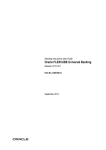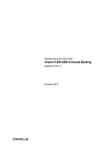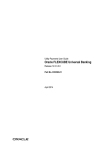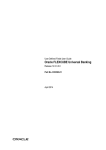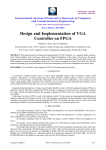Download [August] [2010] Oracle Part Number E51575-01
Transcript
Standing Instructions Version-11.1 9NT1368-ORACLE FCUBSV.UM 11.1.0.0.0.0.0 [August] [2010] Oracle Part Number E51575-01 Document Control Author: Documentation Team Group: UBPG Created on: October 01, 2008 Revision No: Final Updated by: Documentation Team Reviewed by: Development/Testing teams Approved by: Software Quality Assurance Team Updated on: August 13, 2010 Reviewed on: August 13, 2010 Approved on: August 13, 2010 Standing Instructions Table of Contents 1. ABOUT THIS MANUAL................................................................................................................................ 1-1 1.1 INTRODUCTION ........................................................................................................................................... 1-1 1.1.1 Audience ............................................................................................................................................ 1-1 1.1.2 Organization ...................................................................................................................................... 1-1 1.1.3 Glossary of Icons ............................................................................................................................... 1-2 1.1.4 Related Documents ............................................................................................................................ 1-3 2. STANDING INSTRUCTIONS - AN OVERVIEW ...................................................................................... 2-1 2.1 INTRODUCTION ........................................................................................................................................... 2-1 2.2 KEY FEATURES OF SI MODULE .................................................................................................................. 2-1 2.2.1 Processing Standing Payment Orders ............................................................................................... 2-1 2.2.2 Processing Standing Collection Orders............................................................................................. 2-1 2.2.3 Processing Sweep In Transactions .................................................................................................... 2-2 2.2.4 Reports............................................................................................................................................... 2-2 3. DEFINING ATTRIBUTES............................................................................................................................. 3-1 3.1 INTRODUCTION ........................................................................................................................................... 3-1 3.2 CREATING A PRODUCT ............................................................................................................................... 3-1 3.3 SETTING PRODUCT PREFERENCES .............................................................................................................. 3-3 3.3.1 Specifying SI Cycle ............................................................................................................................ 3-4 3.3.2 Indicating the Processing Type.......................................................................................................... 3-9 4. RECORDING AN INSTRUCTION............................................................................................................... 4-1 4.1 INTRODUCTION ........................................................................................................................................... 4-1 4.2 SPECIFYING STANDING INSTRUCTION DETAILS .......................................................................................... 4-1 4.3 OPERATIONS ON INSTRUCTION ................................................................................................................... 4-2 4.4 FEATURES OF SI INPUT DETAILS SCREEN ................................................................................................... 4-2 4.4.1 Specifying Product Code ................................................................................................................... 4-3 4.4.2 Instruction Number............................................................................................................................ 4-3 4.4.3 Value and Due Dates ......................................................................................................................... 4-5 4.4.4 Specifying Debit and Credit Accounts ............................................................................................... 4-6 4.4.5 Specifying Charges ............................................................................................................................ 4-6 4.4.6 Action Code ....................................................................................................................................... 4-7 4.4.7 Maximum Retry Count ....................................................................................................................... 4-7 4.4.8 Specifying Minimum Balance after Sweep......................................................................................... 4-8 4.4.9 Specifying Minimum Sweep Amount .................................................................................................. 4-8 4.4.10 Specifying Your Remarks ................................................................................................................... 4-8 4.5 CHARGES FOR INSTRUCTION....................................................................................................................... 4-8 4.6 SETTLEMENT INSTRUCTIONS ...................................................................................................................... 4-9 4.6.1 Specifying Account Details .............................................................................................................. 4-10 4.7 SUPPRESSING ADVICE .............................................................................................................................. 4-10 4.8 TAX ON INSTRUCTION .............................................................................................................................. 4-10 4.9 VIEWING EVENT DETAILS ON INSTRUCTION ............................................................................................. 4-11 4.10 SI AMENDMENT UPLOAD ......................................................................................................................... 4-12 4.10.1 SI Batch Processing ......................................................................................................................... 4-13 4.10.2 Printing of DD/BC:.......................................................................................................................... 4-14 5. STANDING INSTRUCTIONS DIARY......................................................................................................... 5-1 5.1 MAINTAINING A STANDING INSTRUCTIONS DIARY ..................................................................................... 5-1 5.1.1 Specifying Instruction Type ............................................................................................................... 5-2 5.1.2 Identifying Customer / Savings Account Number .............................................................................. 5-2 5.1.3 Capturing Details of Instruction........................................................................................................ 5-2 5.1.4 Specifying Your Preference for Instruction Type............................................................................... 5-2 5.1.5 Maintaining Details of Event Based Instructions .............................................................................. 5-6 5.1.6 Maintaining Details of a Special Instruction..................................................................................... 5-8 5.1.7 Viewing Standing Instructions associated with a Customer or Customer Account ....................... 5-10 5.1.8 Operations on SI Diary Record ....................................................................................................... 5-10 5.2 MAINTAINING INSTRUCTION TYPES ......................................................................................................... 5-10 5.2.1 Operations on Instruction Type Record........................................................................................... 5-11 6. AUTOMATIC PROCESSING ....................................................................................................................... 6-1 6.1 INTRODUCTION ........................................................................................................................................... 6-1 6.2 HANDLING HOLIDAYS ................................................................................................................................ 6-1 6.3 SI CYCLE DUE TABLE ................................................................................................................................ 6-2 6.4 SPECIFYING SI - CYCLE DETAILS................................................................................................................ 6-3 6.4.1 Values in SI - Cycle Details Screen that can be Modified ................................................................. 6-3 6.4.2 Operations on SI Cycle Details Screen.............................................................................................. 6-4 6.4.3 Operations during Beginning of Day................................................................................................. 6-4 6.4.4 Operations during End of Day........................................................................................................... 6-5 7. ERROR CODES AND MESSAGES.............................................................................................................. 7-1 7.1 8. ERROR CODES AND MESSAGES................................................................................................................... 7-1 REPORTS ........................................................................................................................................................ 8-1 8.1 INTRODUCTION ........................................................................................................................................... 8-1 8.2 SUCCESSFUL OR IGNORED SIS FOR A DAY .................................................................................................. 8-1 8.2.1 Contents of Report ............................................................................................................................. 8-1 8.3 UNSUCCESSFUL SIS FOR THE DAY .............................................................................................................. 8-3 8.3.1 Contents of Report ............................................................................................................................. 8-3 8.4 REPORT ON PENDING COLLECTIONS ........................................................................................................... 8-5 8.4.1 Contents of Report ............................................................................................................................. 8-6 8.5 REPORT ON STANDING INSTRUCTIONS FOR A CUSTOMER ........................................................................... 8-7 8.5.1 Selection Options ............................................................................................................................... 8-7 8.5.2 Contents of Report ............................................................................................................................. 8-7 8.6 REPORT ON STANDING INSTRUCTIONS BY PRODUCT TYPE ....................................................................... 8-10 8.6.1 Selection Options ............................................................................................................................. 8-10 8.6.2 Contents of the Report ..................................................................................................................... 8-11 8.7 STANDING INSTRUCTIONS DUE/PENDING FOR EXECUTION REPORT ......................................................... 8-13 8.7.1 Contents of Report ........................................................................................................................... 8-14 1. About This Manual 1.1 Introduction This manual is designed to help you to quickly get familiar with the Standing Instructions (SI) Module of Oracle FLEXCUBE. It provides an overview to the module and takes you through the various stages in setting up instructions that Oracle FLEXCUBE should automatically process. You can further obtain information specific to a particular field by placing the cursor on the relevant field and striking <F1> on the keyboard. 1.1.1 Audience This manual is intended for the following Users/User Roles: Role Function Product Managers Product definition and authorization Account Officer Entry of Standing Instructions End of Day Operators End and beginning of day related processing functions. BC Report/Query functions Financial Controller/Product Managers Generation of reports 1.1.2 Organization This manual is organized into the following chapters: Chapter 1 About this Manual gives information on the intended audience. It also lists the various chapters covered in this User Manual. Chapter 2 Standing Instructions - An Overview offers an introduction to the module and its features. Chapter 3 Defining Attributes specific to a Standing Instructions Product talks about defining the attributes specific to setting up a Standing Instruction product. Chapter 4 Recording an Instruction deals with the sequence of events involved, in recording an instruction. Chapter 5 Standing Instructions Diary details how you can capture textbased standing instructions and link each instruction with a 1-1 specific customer account or a customer. Chapter 6 Automatic Processing explains the processes that automatically run periodic activities. Chapter 7 Error Codes and Messages for Standing Instructions gives a list of the error messages that you can encounter while working with the module. Chapter 8 Reports gives a detailed account of report generation from this module and the contents of such reports. 1.1.3 Glossary of Icons This User Manual may refer to all or some of the following icons. Icons Function New Copy Save Delete Unlock Print Close Re-open Reverse Template Roll-over Hold Authorize Liquidate Exit 1-2 Icons Function Sign-off Help Add Delete Refer the Procedures User Manual for further details about the icons. 1.1.4 Related Documents You may need to refer to any or all of the User Manuals while working on the SI module: • Signature Verification • Core Services • Limits • Procedures • Products • Settlements • Tax • Charges and Fees 1-3 2. Standing Instructions - an Overview 2.1 Introduction A Standing Instruction (SI) is a service offered to customers of a bank, wherein regular transactions that the customer wants to make are processed as a matter of course instead of initiating specific transactions each time. Once initiated, a standing instruction may go on for many months, or even years, with each cycle being processed automatically. 2.2 Key Features of SI Module As a measure to maximize processing efficiency, the SI module offers the following features: • SI module processes the following types of standing instructions: ¾ Standing Payment Order ¾ Standing Collection Order ¾ Account Sweep (Sweep in and Sweep out) ¾ Variable Payment • SI module is designed to automatically process an instruction that has been recorded, apply relevant charges, and generate advices. Instructions can be recorded for handling a situation where an instruction cannot be processed due to lack of funds. • The product definition facility enables you to create business products with certain attributes. When an instruction is processed under a product, these attributes will be applied automatically. Flexibility, which is the mainstay of Oracle FLEXCUBE’s design, ensures that you have the option to modify the attributes while processing an instruction, to suit specific customer needs. • SI module has a flexible mechanism for defining and applying charges. Charges can be collected either as a rate or as a flat amount on a slab or tier system. These can be defined for products and modified for individual instructions. 2.2.1 Processing Standing Payment Orders A payment order is perhaps the most commonly used service. Under this service, one or more accounts of your customer are debited and one or more credited. This is called a payment order because the service would mostly be used for making a payment, like regular insurance payments. 2.2.2 Processing Standing Collection Orders A collection order is issued by a customer when a certain amount will come in to a customer’s account on a regular basis. The crediting of this amount has to be handled through other modules of Oracle FLEXCUBE -- Remittances or Journal Entries. When a collection type of instruction is recorded, a Collection advice will be generated for the customer who serves as a reminder for follow up on the amount that should be credited into the customer’s account. 2-1 2.2.3 Processing Sweep In Transactions A sweep in instruction will be used when the balance in a customer account should constantly be maintained at a certain balance. A sweep in instruction ensures that whenever the balance in the customer account goes below a certain amount, money is swept in from another account. 2.2.3.1 Processing Sweep Out Transactions A sweep out instruction will be used to move funds out of an account whenever the balance reaches a certain minimum. This is typically used to sweep funds out of a low interest earning account into a high interest earning one. 2.2.3.2 Processing Variable Payment Transactions A variable payment is a variation of the payment type of instruction. In a payment instruction you would fix the amount to be debited, when the instruction is initiated this would be the amount for each cycle. In a variable payment type of instruction, the amount to be debited for each cycle would be different. Examples of variable payments would be the payment of electricity or telephone bills where the amount would be different each time. Thus, for a variable payment type of instruction, you would specify the amount every time a cycle has to be executed. 2.2.4 Reports Information on the SIs defined and processed in Oracle FLEXCUBE can be retrieved in many forms. These reports can either be printed or displayed on the screen. The following are the reports for the SI module: • Successful SIs for the day • Unsuccessful SIs for the day • Pending collections • Standing instructions by customer • Report by SI product type • Standing Instructions Due for Execution 2-2 3. Defining Attributes 3.1 Introduction A product represents a specific service offered by your bank. For example, a certain type of account sweep, a specific type of periodic collection, etc. can be roughly termed a product. Once a product has been defined with specific attributes, individual instructions can be processed under it. This enables quick and uniform processing of instructions in all the branches of your bank. While attributes defined for a product are applied on an instruction processed under it by default, some of them can be modified for a particular instruction. Oracle FLEXCUBE thus offers you flexibility to deal with peculiar conditions that may sometimes be applicable. Standing Instructions are broadly grouped as follows: • Standing payment orders • Standing collection orders • Account sweeps (Sweep in and Sweep out) • Variable payments These are termed product types in Oracle FLEXCUBE. For each product type, you may have many products, which represent the method in which instructions have to be processed. The product type identifies the most basic nature of a product. The subsequent specifications for a product will be based on its type. 3.2 Creating a Product In this chapter, we shall discuss the manner in which you can define attributes specific to a Standing Instruction (SI) product. You can create an SI product in the ‘Standing Instruction Product Definition’ screen invoked from the Application Browser. You can invoke this screen by typing ‘SIDPRMNT’ in the field at the top right corner of the Application tool bar and clicking the adjoining arrow button. 3-1 In this screen, you can enter basic information relating to a SI product such as the Product Code, the Description, etc. For any product you create in Oracle FLEXCUBE, you can define generic attributes, such as branch, currency, and customer restrictions, interest details, tax details, etc., by clicking on the appropriate icon in the horizontal array of icons in this screen. For an SI product, in addition to these generic attributes, you can specifically define other attributes. These attributes are discussed in detail in this chapter. You can define the attributes specific to an SI product in the SI Product Definition Main screen and the SI Product Preferences screen. In these screens, you can specify the product type and set the product preferences respectively. For further information on the generic attributes that you can define for a product, please refer the following Oracle FLEXCUBE User Manuals: • Products • Interest • User Defined Fields • Settlements Product Code You need to identify a standing instruction product that you are creating with a unique Product Code. This code should be unique across all the modules of Oracle FLEXCUBE. This code should be different from the Instruction Code that is given 3-2 Instruction Code You should give the product another unique code that will be used to generate the Instruction Reference Number. This code should be different from the Product Code that will be used, to generate the contract reference number for each cycle of the instruction. Product Group Grouping products, according to the common features they share, helps you organize information relating to the services you provide. Product Groups also help you retrieve information easily. You can invoke a list of the product groups that you have maintained in your bank and choose the product group to which the product that you are creating belongs. 3.2.1.1 Defining the Product Type The product type identifies the most basic nature of a product. The remaining attributes that you define for a product will depend on its product type. A product that you are defining can have one of the following types: 3.3 • Standing payment orders • Standing collection orders • Account sweeps -- in or out • Variable payments Setting Product Preferences Preferences are the options that are available to you for defining the attributes of a product. The options you choose, ultimately, shape the product. Some of the attributes defined as preferences can be changed when an instruction is processed under the product. 3-3 Click ‘Preferences’ button to invoke the SI Product ‘Preferences’ screen. The product code together with a brief description that you specified for the product in the product definition screen will be displayed at the top of the screen. Not all product preferences are allowed to be amended, after the product has been authorized once. So care needs to be taken before authorization of the product to ensure that the product attributes (preferences) have been maintained correctly. 3.3.1 Specifying SI Cycle The SI cycle defines the frequency at which the instruction is to be executed. This can be defined in days, months or years. For example, you can choose to define a payment order on a daily basis, or every 60 days or 150 days, or a payment every three months or six months. You can also define a payment that is annual or every two years. Example Your customer Ms. Tanya Agnihotri wishes to pay her insurance premium. She could do it on a monthly basis, a quarterly basis or on an annual basis. This can be defined in three ways: • In days - 30 days, 90 days and 365 days • In months - 1 month, 3 months and 12 months • In years - not possible for the first two, but 1 year for the third frequency Rate Type You have to specify the Rate Type that should be used for SI transactions. Click on the option list for a display of all the Rate Types maintained through the Rate Type Definition screen. 3.3.1.1 Holiday Exception Code You should define the action that is to be taken if the due date falls on a calendar holiday. Since SI’s are processed at regular intervals, often it may happen that a due date for an instruction will be a holiday. In such a case, you can: 3-4 • Bring the due date backward, in which case the instruction will be processed on the working day before the holiday. • Push the due date forward, in which case the instruction will be processed on the working day after the holiday; or • Let the cycle lapse, in which case the instruction will not be processed for the cycle at all. If the due date is brought backward or pushed forward, the value date of the accounting entry for the instruction will be the working day on which it was processed. Example Taking up the same example that was discussed earlier, Ms. Agnihotri’s insurance is due on 01 June each year. 01 June 2003 is a Sunday, and hence a banking holiday. • If the code is Forward, then the due date is moved forward by a day and payment is made on the next working day, i.e. 02 June 2003. • If the code is Backward, then the due date is moved back by a day and the payment is processed on the previous working day, i.e. 31 May 2003. • If the code is Lapse, the current cycle is not executed. 3.3.1.2 Minimum Sweep Amount This applies for a sweep in and sweep out type of product. You should define the minimum amount that is to be transferred in an account sweep. If the amount in the Sweep From account is more than the defined SI amount but the sweep amount is less than the minimum sweep amount, then the sweep will not be executed. 3.3.1.3 Action Code Amount The SI is processed on its due date and the necessary transaction is effected. An SI will not be processed if there are insufficient funds in the account to be debited. In such a case, the Action Code specified for the product will decide the action to be taken. It could be: Partial Liquidation The system will first attempt an SUXS. If SUXS fails due to insufficient funds (Available Balance < SI Amount) in the account, the SI will be executed to the extent of the funds available. This is known as partial execution. The event ‘PEXC’ is triggered during a partial liquidation/execution. The rest of the amount will be collected during subsequent retries, subject to the ‘Maximum Retries’ defined for the instruction. The system will attempt SUXS only once during the day (first time). If it fails, only PEXC will be attempted on every subsequent retry. Therefore, if between the SUXS and PEXC events, the available balance increases to cater to the full SI, the PEXC event ONLY will be triggered. This means that the entire SI amount may be posted for the PEXC event as well. However, the event ‘PEXC’ is triggered only if the ‘Action Code’ is specified as ‘Partial Liquidation’. Full pending The SI is not executed until there are sufficient funds in the account. The system will re-execute the instruction daily, for the number of times defined as ‘Maximum Retries’. In this case, only an ‘SUXS’ is triggered subject to the availability of funds to the extent of the SI amount. The event ‘PEXC’ will not be triggered even if partial funds are available 3-5 in the account. Ignore The current installment is not executed at all. The next cycle will be processed on the next due date. Await further instructions The instruction is not processed again until its action code is changed in the Instructions Due Table. The SI Cycle Details table is automatically created when the automatic processing of SIs for the day takes place (for details on this, please refer the chapter on Automatic Processing). For an instruction, you can change the action code in this table so that you may process an unsuccessful SI. Force In this case, the instruction is executed, leaving a debit balance in the account. Example You have a payment order to pay USD 6000 as annual premium to an insurance company for Ms. Tanya Agnihotri. This amount is to be transferred from her savings account on the 01 June every year. If the account balance in her account is only USD 5000, when the insurance payment is due, the SI cannot be processed, as funds are insufficient. The processing of the instruction will depend on the action code, as follows: Partial liquidation In this case, you would transfer USD 5000 to the insurance company. Full pending Then you would not make any insurance payment for this year. The system will re-execute the instruction daily, for the number of times defined as Maximum retries count. Ignore The payment to the company will not be made this year, but the next payment will be processed. Await further instructions Future insurance payments for Ms. Tanya Agnihotri will not be made until a change in the Action Code is indicated in the Instructions Due table. Force The payment will be made, leaving a debit balance in the account. 3.3.1.4 Maximum Retry Count The action code for a product indicates the action to be taken, when the account to be debited for an instruction does not have the requisite balance. One of the actions could be for the full amount to be kept pending and the instruction re-executed daily. However, you can fix the maximum number of times the SI should be re-executed. This number is defined as the maximum retry count. The SI for the current cycle will be skipped after this number has been reached. Please note that this number will also include the first time the system tries to execute the instruction. That is, if the maximum retry count is five, the system will try to re-execute the SI after the first try, for four times. 3-6 3.3.1.5 SI Type The number of accounts involved in an instruction may be more than one. Typically, you would debit one customer account and credit another to execute an instruction. All the examples we have discussed so belong to this category. Under some circumstances, you may have to debit a single account and credit many accounts or vice versa. In Oracle FLEXCUBE, you have to specify this by defining the appropriate SI type for the product. The options available are: One to one One account has to be debited and one credited. One to many One account has to be debited and more than one credited. Many to one More than one account has to be debited and one account credited. Many to Many More than one account has to be debited and more than one account credited. 3.3.1.6 Execution Periodicity You should indicate the periodicity with which the standing instruction has to be executed. You can indicate it in days, months, years or as a combination of all three. You can define execution periodicity for Sweep In/Sweep Out type of instructions also. 3.3.1.7 Transfer Type For contracts associated with the product you need to indicate whether the payment details need to be structured or whether the details can be in free format. The format in which payment messages will be sent for all contracts involved in the product will depend on your specification in this field. 3.3.1.8 Authorization Re-key All operations on an instruction (input, modification, etc.) have to be authorized: • By a user other than the one who carried out the operation, and • Before you can begin the End-of-Day operations When you invoke the initiation of an instruction for authorization − as a cross-checking mechanism, to ensure that you are calling the right instruction − you can specify that the values of certain fields should be entered, before the other details are displayed. The complete details of the instruction will be displayed only after the values to these fields are entered. This is called the re-key option. The fields for which the values have to be given are called the re-key fields. If no re-key fields have been defined, the details of the instruction will be displayed immediately once the authorizer calls the SI for authorization. The re-key option also serves as a means of ensuring the accuracy of inputs. 3-7 Duplication Recognition You can specify the following details related to duplication check for transactions. The duplication check is carried out based on the combination of the preferences maintained at the SI product level. Product Code Check this box to indicate that the product code needs to be considered while checking for duplicate transactions. Cr Account Check this box to indicate that the Cr account needs to be considered while checking for duplicate transactions. SI Currency Check this box to indicate that the SI currency needs to be considered while checking for duplicate transactions. SI Amount Check this box to indicate that the SI amount needs to be considered while checking for duplicate transactions. Book Date Check this box to indicate that the booking date needs to be considered while checking for duplicate transactions. First Execution Value Date Check this box to indicate that the value date of the first execution of the Standing Instruction needs to be considered while checking for duplicate transactions. Execution Periodicity Check this box to indicate that the periodicity of the Standing Instruction needs to be considered while checking for duplicate transactions. The check for duplicate transactions is carried out based on the duplication check days maintained at Branch Parameter level. An override message gets displayed if any duplicate transaction is encountered. If none of the above checkboxes are selected, duplication check will not be performed, even if duplication check details have been specified at branch parameter level. 3-8 For more details on the duplication check preferences maintained at branch level, refer the section titled ‘Maintaining Duplication Check Details’ in Core Services user manual. 3.3.1.9 Referral Required Referral refers to the process of handling customer transactions which force the accounts involved in such a transaction to exceed the overdraft limit. Standing Instructions are examples of typical transactions, which can force an account to move into overdraft. While maintaining the details of an SI product you can indicate whether transactions involving the product need to be considered for referral checks. Enabling this option indicates that transactions within the product need to be considered for referral. If a product is marked for referral, the details of transactions resulting in the account (involved in the transaction) moving into Overdraft will be sent to the Referral Queue. Note the following: • The referral is processed only for those SI instructions in which the Action code is ‘Wait for Further Instruction’ and the processing time is ‘BOD’. Referral is not processed for the other SI Instruction. • If an SI transaction breaches the specified limits, the details of the transaction will be displayed in the Unposted Entries section of the queue. You can choose to either accept or reject it. For further details on Referrals refer to the Processing Referrals in Oracle FLEXCUBE chapter of the Core Entities manual. 3.3.2 Indicating the Processing Type Only while creating a payment type (payment or variable payment) or sweep type (sweep in or sweep out) of product you have to specify the stage of end of cycle processing when an instruction under the product has to be processed. The following options are available: • EOD (End of Day) • BOD (Beginning of Day) • INTRADAY (During the Day) When an instruction is processed under a product, with processing time as BOD or EOD, the accounting entries will be passed either during the beginning of day or end of day, on the due date. When the processing is end of day, the instruction will be executed when the automatic processes for the SI module is run after End of Transaction Input has been marked for the day. For products with processing time as intra-day, the instruction will be executed during the day i.e. during the normal transaction input. However, such transactions will be maintained in separate groups to be executed at different times during the day. 3-9 4. Recording an Instruction 4.1 Introduction A product is a specific service that you offer your customers. For example, you may process periodic insurance payments, account sweeps subject to a specific balance, etc. These services should be defined as products. A product, you will notice, helps you classify the standing instruction services that you offer, according to broad similarities. The advantage of defining a product is that you can define certain general attributes for a product that will default to all instructions involving it. Every time you have to process an instruction for a customer you need not specify its general attributes since they are inherited from the product involved. Some of these attributes may have to be changed for an instruction. Further, attributes specific to an instruction, like the accounts involved, the currency and amount of transfer, etc. have to be specified when an instruction is initiated. 4.2 Specifying Standing Instruction Details The details of an instruction are recorded in the ‘Standing Instruction Online Detailed’ screen. You can invoke this screen by typing ‘SIDCONON’ in the field at the top right corner of the Application tool bar and clicking the adjoining arrow button. 4-1 From this screen, you can navigate to the following screens that will contain values that are applicable by default depending on the product involving the instruction: • SI Advices screen • SI Charges screen • SI Tax Details screen You can choose to modify or waive the charges, suppress the generation of an advice, or waive a tax. 4.3 Operations on Instruction The following are the related activities that you can perform on an instruction: • Open an instruction • Delete the details of an instruction • Amend the details of an instruction • Authorize an instruction • Close an instruction • Reopen an instruction Please refer to the user manual on common procedures for details on these procedures. 4.4 Features of SI Input Details Screen Every product that is created in your bank has certain general attributes. An instruction that you record acquires the general attributes that were defined for the product that it involves. These general attributes are: • The product code, description, slogan, start and end date for the product and remarks • How the instruction is to be processed in case the processing date falls on a holiday • The mode of payment and the currency rate that is to be used in case it is a crosscurrency transaction • The frequency of the execution • The action to be taken if the account to be debited for an instruction does not have sufficient funds • Details of charges applicable on an instruction • Other tax details like the component being taxed, the type of tax and the event (opening, execution, etc.) upon which it is applied • The accounting roles and the General Ledgers for accounting purposes when an event (execution, partial execution, etc.) takes place, and the advices to be generated • The customer categories and customers for whom you can process instructions involving the product 4-2 • The branch and currency restrictions An instruction that you record acquires the details specified for the product that it involves. However, you also need to enter information that is specific to the instruction. You can enter details specific to an instruction in the SI Contract Details screen. You have to specify the following details for each instruction: • Counterparty on behalf of whom the instruction is being recorded • Currency of the instruction • Amount that has to be transferred during each cycle • Account that has to be debited • Account that has to be credited • Date on which the instruction has to be executed (first due date) • Date until which the instruction has to be executed (expiry date) • If the debit account is involved in more than one instructions falling due on the same day, you can allot the priority with which an instruction has to be processed. The following attributes will be inherited from the product and you can change them: • Maximum retry count • Action code applicable if the instruction cannot be processed due to insufficient funds in the debit account • Execution Periodicity For charges, you should indicate who bears the charge: the remitter or the beneficiary. You can also indicate the events that should be charged: successful execution (SUXS), partial execution (PEXC), or rejection (REJT). 4.4.1 Specifying Product Code Every instruction that you record would involve a specific service that you offer (which you defined as a product). When recording an instruction, you should specify the product that it involves. All the attributes of the product that you specify will apply to the instruction. However, you can change some of these attributes. 4.4.2 Instruction Number The Instruction Number identifies the instruction. It is automatically generated by the system for each instruction. The Instruction Number is a combination of the three character branch code, the four character instruction code, the date on which the instruction is recorded (in Julian format) and a running serial number. 4-3 The Julian Date has the following format: YYDDD Here, YY stands for the last two digits of the year and DDD for the number of days that have elapsed in the year. Example January 31, 1998 translates into the Julian Date: 98031. Similarly, February 5, 1998 becomes 98036 in the Julian format. Here, 036 is arrived at by adding the number of days elapsed in January with those that elapsed in February (31+5=36). 4.4.2.1 User Instruction Number An instruction can be identified by two different numbers: one is allotted by Oracle FLEXCUBE while the other one can be a number input by you, which should typically be the number with which your customer identifies the instruction, called the User Instruction Number. No two instructions can have the same User Instruction Number. By default, the Instruction Number allotted by Oracle FLEXCUBE and the User Instruction Number will be the same. 4.4.2.2 Specifying Customer When entering the details of an instruction, you should specify the customer on whose behalf you are recording it. The category of customers (or the customers themselves) who can record standing instructions is defined for the product. Specify the code of a customer who falls into a category allowed for the product. 4.4.2.3 Execution Periodicity The execution periodicity defined for the product will be picked up automatically. You can modify it to suit the instruction you are processing. 4.4.2.4 Specifying Period for which Instruction should be Executed Each instruction is valid for a specific period of time. This must be defined for the instruction. The first due date and the expiry date will mark the life-span of the instruction. The value date for the first execution is usually the same date as the first due date, unless that is a holiday. In that case, the First Value Date will be computed based on the holiday handling specifications for the product. By default, the First Due Date will be today s date. You can change it to a date in the future. Oracle FLEXCUBE will automatically compute the next due date and next value date based on the periodicity defined for the product. The Expiry Date will be the date until when the instruction will be processed. 4-4 4.4.2.5 Specifying Instruction Currency and Amount The SI amount that you specify while processing an instruction has different interpretations, depending on the type of SI, as follows: Payment This is the amount that should be transferred whenever the instruction is executed. Collection This is the amount that would be coming in for the customer, for every cycle. This amount is for information purposes only and no accounting entries will be passed for it. Sweep in This is the balance in the credit account that should trigger a sweep in of funds. The sweep transaction will be executed if the balance in the credit account goes below this amount. Sweep out This is the balance in the debit account that should trigger a sweep out of funds. The sweep transaction will be executed if the balance in the debit account becomes greater than this amount. Variable Payment This is the amount that should be processed for the next cycle of the variable payment transaction. Every time a cycle of the variable payment instruction is executed, the SI Amount field is reset to zero. You should put in the SI Amount applicable for the next cycle through the Amend operation on the SI Input Detailed screen. If the amount is not changed and it remains as zero on the Value Date of the instruction, Oracle FLEXCUBE will not process it; it will allot it an unprocessed status. You should change the amount through the SI Cycle Details table before the variable payment can be processed during a subsequent retry. The instruction currency is the one in which the instruction should be executed. The SI amount that you specify is taken to be in the instruction currency. The currency of the debit and credit accounts, can, however, be different from this currency. In such a case, Oracle FLEXCUBE will use the conversion rate specified for the product. Further, the holiday checking for an instruction will be done for the instruction currency. 4.4.3 Value and Due Dates The First Execution Value Date is the date you should specify while processing an instruction. This date is used by Oracle FLEXCUBE for the following purposes: • The first execution of the instruction is done on this date, and • The value dates for subsequent executions will be computed based on this date and the frequency of the instruction. 4-5 Thus, the Next Execution Value Date is the date on which the next cycle of the instruction falls due. The First Execution Due Date and the Next execution Due Date is relevant only if any of the value dates fall on a holiday in the instruction currency. In such a case, the Due Date will be the date adjusted according to the holiday handling specifications for the product under which the instruction is being processed. The holiday handling specification could be to move the Value Date either backwards or forwards. On a rare occasion, an instruction cycle that falls on a holiday will be ignored, if the holiday rules so specifies. 4.4.4 Specifying Debit and Credit Accounts In the case of one-to-one instructions, you should define one debit and one credit account. For a many-to-one or one-to-many instruction, the first account you specify will be defaulted, and they can be changed. If you have specified an account that uses an account class that is restricted for the product, an override is sought when you attempt to save the contract. 4.4.4.1 Debit Account Description In this field, the description of the corresponding debit account is displayed by the system, when you specify or select the Customer Number or Customer Account from the LOV. If the debit account number keyed in has only one value matching it in the LOV, then system will not open the LOV on tab out and the description of the debit account will be automatically displayed 4.4.4.2 Credit Account Description In this field, the description of the corresponding credit account is displayed by the system, when you specify or select the Customer Number or Customer Account from the LOV. If the credit account number keyed in has only one value matching it in the LOV, then system will not open the LOV on tab out and the description of the credit account will be automatically displayed. 4.4.5 Specifying Charges The charges applicable for an instruction are defined for the product under which the instruction is processed. These charges will be defaulted for the instruction you are processing. A charge can be applied for the following events: • Successful execution (SUXS), • Partial execution (PEXC), or • Rejection (REJT) You should specify the party who bears the charge: the remitter or the beneficiary. 4-6 4.4.6 Action Code The Action Code indicates the action to be taken if the account to be debited in order to execute an instruction does not have the necessary funds. This applies to a payment or a variable payment type of product. This Action Code is defined for the product under which an instruction is processed. You can change it for the instruction you are processing. The following are the Action Codes that can be specified: Partial Liquidation If the account has insufficient funds (Available Balance < SI Amount), the SI is executed to the extent of the funds available. This is known as partial execution. The event ‘PEXC’ is triggered during a partial liquidation/execution. The event ‘PEXC’ is triggered during a partial liquidation/execution. The rest of the amount will be collected during subsequent retries, subject to the ‘Maximum Retries’ defined for the instruction. The system will attempt SUXS only once during the day (first time). If it fails, only PEXC will be attempted on every subsequent retry. Therefore, if between the SUXS and PEXC events, the available balance increases to cater to the full SI, the PEXC event ONLY will be triggered. This means that the entire SI amount may be posted for the PEXC event as well. However, the event ‘PEXC’ is triggered only if the ‘Action Code’ is specified as ‘Partial Liquidation’. Full Pending The SI is not executed until there are sufficient funds in the account. The system will re-execute the instruction daily, for the number of times defined as ‘Maximum Retries’. In this case, only an ‘SUXS’ is triggered subject to the availability of funds to the extent of the SI amount. The event ‘PEXC’ will not be triggered even if partial funds are available in the account. Ignore The current installment is not executed at all. The next cycle will be processed on the next due date. Await further instructions The instruction is not processed again until its action code is changed in the Instructions Due Table. The SI Cycle Details table is automatically created when the automatic processing of SIs for the day takes place (for details on this, please refer to the chapter on Automatic Processing). For an instruction, you can change the action code in this table so that you may process an unsuccessful SI. Force In this case, the instruction is executed, leaving a debit balance in the account. 4.4.7 Maximum Retry Count 4-7 If the Action Code for an instruction indicates that the full amount should be kept pending, or the partial amount has to be liquidated, you can define the maximum number of times for which Oracle FLEXCUBE should try to re-execute the instruction. This attribute is defined for the product and will be defaulted for the instruction, and you can modify it. 4.4.8 Specifying Minimum Balance after Sweep For a sweep in type of instruction, you should specify the amount that should be left in the debit account after the sweep is executed. A sweep in instruction will be executed when the balance in the credit account goes below the SI Amount. The minimum balance after sweep ensures that a certain balance is left in the debit account and only excess amount is swept. 4.4.9 Specifying Minimum Sweep Amount This applies for a sweep out type of product. You should define the minimum amount that is to be transferred in an account sweep. If the amount in the Sweep From account is more than the defined SI amount but the sweep amount is less than the minimum sweep amount, the sweep will not be executed. Example An account sweep for Mr. Sam Brown’s account is defined to transfer any amount over USD 10, 000 to another account. The minimum sweep amount for the product is defined at USD 2,500. If the balance in Mr. Brown s account is USD 12,000, the instruction will not be processed, as USD 2,000 is less than the Minimum Sweep Amount. 4.4.10 Specifying Your Remarks You can enter information describing the instruction that you are recording. This will be available when you retrieve information on the instruction. However, this information will not be printed on any advice printed for the customer s benefit. This information will be displayed whenever you retrieve information on the instruction either as a display or in print. 4.5 Charges for Instruction The charges that are applicable for an instruction are defined for the product under which the instruction is processed. You have the option to: • Modify the amount that is applied by default; or • Waive the application of the charge altogether. Click ‘Charges’ button in the SI Input -- Detailed screen. The ‘Charge Details’ screen will be displayed. 4-8 The charges applicable for the events that have been processed till date will be displayed. Tick the Waiver field if you want to waive the charges applicable. 4.6 Settlement Instructions The account(s) through which a customer wishes to settle the charges have to be indicated through the SI Settlements screen. Click ‘Settlements’ button in the SI Input -- Detailed screen to invoke the ‘Settlements Details’ screen. Besides the account details, the other details that you can specify include the currency in which the component is expressed, the payment account and its currency, the branch of your bank to which the account belongs, the exchange rate (in the case of the component currency being different from the account currency). If you have specified an account that uses an account class that is restricted for the product, an override is sought when you attempt to save the contract. Depending on the component, the system will also display whether the account involved in an entry has to be debited or credited: • P indicates you credit (Pay to) the account involved; and • R indicates you debit (Receive from) the account involved. You can specify the mode of payment (by SWIFT or by an instrument), and also verify customer signatures through the Settlement Instructions screen. 4-9 4.6.1 Specifying Account Details You can specify the following details in the ‘Account Details’ tab. Negotiated Cost Rate Specify the negotiated cost rate that should be used for foreign currency transactions between the treasury and the branch. You need to specify the rate only when the currencies involved in the transaction are different. Otherwise, it will be a normal transaction. Negotiated Reference Number Specify the unique reference number that should be used for negotiation of cost rate, in foreign currency transaction. If you have specified the negotiated cost rate, then you need to specify the negotiated reference number also. Oracle FLEXCUBE books then online revaluation entries based on the difference in exchange rate between the negotiated cost rate and transaction rate. 4.7 Suppressing Advice The advices to be sent for an event are defined for the product under which the instruction is processed. These advices will, by default be generated for an instruction. However, while processing an instruction you have the option to suppress the generation of an advice. Click ‘Advices’ button in the SI Input Detailed screen. The ‘Contract Advices’ screen will be displayed. The screen will contain the details of the advices applicable for the event you are processing. If you want to suppress an advice, select Yes in the Suppress column. Since an advice for a standing instruction is always sent by mail, the priority column does not apply. 4.8 Tax on Instruction You can process tax on the charges that you earn for an instruction and on the instruction amount itself. Tax is applied based on the tax scheme linked to the product, under which the instruction is processed. While processing an instruction, you can choose to waive the tax applicable. Click ‘Tax’ button. The ‘Tax Details’ screen will be displayed. 4-10 Tick the Waiver button if you want to waive the taxes applicable. 4.9 Viewing Event Details on Instruction The event details screen of instruction processing will show the details of the accounting entries generated for an instruction. Click ‘Events’ button in the SI Input Detailed View screen to go to the SI Contract - Events, Accounting Entries and Overrides screen. For the event that is highlighted, the details of accounting entries and the overrides that were given when the event was stored are shown. For each accounting entry, the following details are provided: • Branch • Account • Transaction Code • Booking Date 4-11 • Value Date • Dr/Cr indicator • CCY (Currency) • Conversion rate • Amount in contract CCY • Amount in local currency • Whether the instruction is still active (meaning that cycles are being executed for the instruction) • Whether the last activity on the instruction is authorized You can use the arrow buttons to navigate through the various events. 4.10 SI Amendment Upload Oracle FLEXCUBE supports the amendment upload of Standing Instructions by way of the FLEXML interface. Oracle FLEXCUBE allows amendment of only authorized instructions. The following fields will be made available for amendment at the instruction level: • Counterparty • Execution frequency (Days, Months, Year) Changing the counterparty will lead to re-pickup of subsystems. The following fields will be made available for amendment at the contract level: • Action Code • Charge On Success • Charge On Partial Success • Charge On Reject • Retry Count • Charge Whom • Minimum Sweep Amount • Minimum Balance After Sweep • SI Amount • SI Amount Ccy • Dr Account Branch 4-12 • Dr Account • Cr Account Branch • Cr Account The FLEXML interface will carry out the following as a part of the amendment upload: • A new version of the instruction is created and based on the data that is being amended, replication / re-pickup for subsystem is carried out. Subsequently the accounting and advice generation based on the amendment event maintenance in product definition will be processed. • The post upload auth status will be accepted as a parameter to the amendment service. • The action to be taken on override and exception is similar to the processing done as in the case of Save of a new instruction. 4.10.1 SI Batch Processing • The system would initially post the accounting entries by debiting the customer account and crediting the payable GL for the SI transaction amount. • The system would prepare the instrument transaction data to be uploaded and the same would be uploaded to create the instrument transaction. • By debiting Payable GL, DD/BC transaction would be created as per the Instrument ARC maintenance. • Once DD/BC issue transaction is created, the transactions would be available as a part of Web Branch DD/BC issued data stores • After that system would do the message handoff to generate the DD/PO • After successful generation of instrument message system would internally update the instrument number for the contract • In case of foreign currency instruments, the system would generate MT110 along with the Draft/PO • MT110 would be created with the message type as ‘DD_ISSUE’ The following setting needs to be done for SI Transaction: • In SI details screen, any instruction for issuing DD/PO, the ‘Credit Account’ will be selected as a ‘Payable GL’. • During SI save ,when the user selects ‘Credit Account’ as ‘Payable GL’ and ‘Payment Mode’ as ‘Instrument’, the system performs following validations: • ¾ Instrument Type should not be null ¾ Ultimate beneficiary details are mandatory (Name and Address) ¾ Payable Bank and Branch should not be null In SI Settlements, the user has to select the appropriate Instrument Type to generate DD/PO. For issuing Demand Drafts and Banker’s Cheque instrument types should be DDG/DDA and BCG/BCA respectively. 4-13 • In SI settlements ‘Other Details’ tab ,option ‘Waive Charges on Instrument Issue’ has to be selected to waive-off any instrument charges maintained at ARC maintenance. • SI batch that executes would create DD/BC issue transaction 4.10.2 Printing of DD/BC: All the generated Drafts/Banker’s Cheques will be spooled to a file (based on Instrument type) and these spooled files would be sent to designated DD printing system in bank. Note the following: • The ‘Message Printing’ (MSDPRINT) screen would be used to spool the generated DD/PO s during SI batch. • The instruments for DD and PO would be identified with the message type ‘DEMDRAFT’ and ‘MCK’ respectively. • The ‘Message Printing’ screen has the provision to spool instruments based on Customer. That is ‘Customer Account’ and ‘Instrument’ 4-14 5. Standing Instructions Diary 5.1 Maintaining a Standing Instructions Diary In Oracle FLEXCUBE, you can capture text-based standing instructions and link each instruction with a specific customer account or a customer through the Standing Instruction Diary screen. The diary of text based standing instructions that you maintain is meant for your bank’s own internal reference. Since each instruction is linked to a customer account or a customer, it will be executed automatically by the system as of the due date, depending on the execution parameters defined for each instruction. For instance, let us assume that Silas Marner, an individual type of customer, having a GBP Savings Account in your bank has instructed you to execute an instruction as and when the current balance in his account comes down to GBP 1000. You have to associate the standing instruction with the customer account whereby the instruction will be executed suitably. Every time you invoke the SI Diary details screen to capture the details of a new record, the system automatically assigns an instruction number to the new record. In Oracle FLEXCUBE, instruction numbers are generated automatically and sequentially to uniquely identify a record. The instruction number is a combination of a three-digit branch code, a four-digit hard coded number, a five-digit Julian Date, and a four-digit serial number. In this screen, you can specify the following attributes of the SI. 5-1 5.1.1 Specifying Instruction Type You can indicate whether the standing instruction is to be associated with a Customer Account or whether it is to be associated with a Customer Code. 5.1.2 Identifying Customer / Savings Account Number You have to identify the code assigned to the particular customer if you have indicated that the standing instruction is to be associated with a customer. Similarly, if you have indicated that the standing instruction should be maintained at the account level, you have to select the account number. The option list positioned next to this field displays a list of customer account numbers or customer codes depending on your specification in the Type field. After you select the Customer Code/Account Number, the branch code of the branch in which the rule is being created will be displayed in the respective field. 5.1.3 Capturing Details of Instruction You can key-in the details of the instruction that is to be associated with particular Account/Customer in a free format text format. Click the icon positioned next to this field. The Instruction Details screen will be displayed. Key-in the instruction and click on the ‘Ok’ button. 5.1.4 Specifying Your Preference for Instruction Type Each instruction that you maintain will be executed based on a specified frequency or on a specific event. You can indicate your preference depending on whether the instruction is to be associated with a customer or a customer account. Instructions that are associated with customers can only be frequency based. However, those instructions which are to be associated with customer accounts can either be frequency based or event based. You can also choose to maintain details of a special instruction in this screen. For instance, let us assume that Mrs. Wendy Klien is a high net worth customer of your bank. You would like to send her a New Year greeting. Since this is a once in a year occasion you can either choose to base this instruction on a yearly frequency or maintain it as a special instruction. 5-2 Maintaining details of Frequency Based instructions Apart from the section titled Main Details, you will notice that the SI Diary screen has been divided into three other sections - Frequency Details, Event Details, and Special Instruction. You can capture the execution periodicity details of an instruction under the Frequency Details section of this screen. Setting the Execution Periodicity If you have indicated that the particular instruction is to be Frequency Based, you have to set the frequency at which the system has to execute the instruction. The options available are: • Days – indicating that the instruction should be executed as per the number of days specified in this field. You can choose to execute the instruction on a daily basis or once in every few days. For instance, your requirement is for the standing instruction to be carried out once in every 20 days. You have to capture 20 in this field. The system will execute the order once in every 20 days. • Months - indicating that the execution periodicity should be on a monthly basis. For example, if you want to execute the instruction once in every three months specify 3 in this field. • Years – indicating that the instruction should be executed based on a yearly frequency. It could be either annually, bi-annually, once in three years, etc depending on your requirement. Indicating your preferences for the First Due Date and the Month end cycles After you specify the execution periodicity, you have to indicate the date on which the standing instruction is to be carried out for the very first time. Since the instruction is yet to be carried out by the system, the first due date will be defaulted as the next due date. You will need to indicate whether the instruction is to be carried out during the month-end or whether it should be executed as of the next due date. 5-3 The scenarios in which you will have to specifically indicate that the instruction is to be executed during the month-end are given below: Scenario I Lets us assume that you have set the frequency as Monthly, Yearly or as a combination and identified any one of the following dates as the First Due Date: • 29th February 2000 • 30th April 2000 • 30th June 2000 • 30th September 2000 • 30th November 2000 When you specify the First Due Date which is other than the one specified before, then the system displays an override message and it does not allow you to check the field, ‘Month End’. "Specified date is not the month end” If you specify that the instruction should be executed only on month-ends the system auto calculates the Next Due Date and displays this dates in the respective field: First Due Date Month End Next Due Date 29th Feb 2000 b 29th Feb 2000 30th April 2000 b 30th April 2000 30th June 2000 b 30th June 2000 30th Sept 2000 b 30th Sept 2000 30th Nov 2000 b 30th Nov 2000 Scenario II You have set the frequency as Yearly, Monthly or as a combination and identified the 28th of February 2003 as the First Due Date. You have also indicated that the instruction should be executed only at the end of the month. In keeping with your specification the system displays the Next Due Date as 28th of February 2003. Scenario III Let us suppose that you have set the frequency as Monthly, Yearly or as a combination and identified any one of the following dates as the First Due Date: • 31st January 2000 • 31st March 2000 • 31st May 2000 • 31st July 2000 • 31st August 2000 • 31st October 2000 5-4 • 31st December 2000 The system automatically checks and enables the month-end check box option. You will not be allowed to change it. The instruction will be executed on the last day of the month. Specifying the holiday treatment preference You have to indicate the preferred holiday treatment that should be followed for the frequency due dates that you have specified. The options available are as follows: • Don’t Execute it – indicating that if the Next Due Date falls on a holiday the instruction should not be carried out. • Next Working Day – indicating that if the Next Due Date falls on a holiday the instruction should be executed on the next working day after the holiday. • Previous Working Day – indicating that if the Next Due Date falls on a holiday, the instruction should be executed on the working day before the holiday. You can select the appropriate holiday treatment preference. Auto calculating the Next Execution Date The system arrives at the Next Execution Date based on your specifications in the Holiday Preference field and the Local Holiday maintenance screen of the Core Service module. Let us assume that in the Holiday maintenance screen you have marked all weekends as holidays. For the examples mentioned under Scenario I in the section titled ‘Indicating your preferences for the First Due Date and the Month end cycles’ the Next Execution Date will be displayed as follows: First Due Date Month End Next Due Date Holiday Preference Next Execution Date 29th Feb 2000 b 29th Feb 2000 Next Working Day 29th Feb 2000 30th April 2000 b 30th April 2000 Previous Working Day 28th April 2000 30th June 2000 b 30th June 2000 Don’t Execute 30th June 2000 30th Sept 2000 b 30th Sept 2000 Don’t Execute 30th Sept 2000 30th Nov 2000 b 30th Nov 2000 Next Working Day 30th Nov 2000. 5-5 Suppose you specify that the instruction need not be executed on the Month-end, the Next Execution date will be displayed as follows: First Due Date Month End Next Due Date Holiday Preference Next Execution Date 28th Feb 2000 □ 28th Feb 2000 Don’t Execute 28th February 2000 30th April 2000 □ 30th April 2000 Next Working Day 1st May 2000 30th June 2000 □ 30th June 2000 Next Working Day 30th June 2000 30th Sept 2000 □ 30th Sept 2000 Next Working Day 2nd October 2000 30th Nov 2000 □ 30th Nov 2000 Don’t Execute 30th Nov 2000. Scenario II th You have set the frequency as Yearly, Monthly or as a combination and identified the 28 of February 2003 as the First Due Date. You have also indicated that the instruction should be executed only at the end of the month. Since all weekends are observed as holidays at your bank, you have indicated that if the first due date is a holiday, the instruction should be executed on the next working day after the holiday. th In keeping with your specification the system displays the Next Due Date as 28 of February 2003.The Next th Execution Date too will be 28 of February 2003, since it is a Friday. 5.1.5 Maintaining Details of Event Based Instructions If you have indicated that the instruction is to be executed based on an event, click on the Event Details tab and specify the event specific details. 5-6 Indicating the condition based on which the event gets triggered You have to specify the condition or factor within an account, which is instrumental in triggering the standing instruction. You can achieve this by identifying the conditional element and linking it with an operator and a conditional value. First, identify the conditional element, which forms the basis for the event. You have the option of selecting any one of the following events: • Current Balance • Available Balance • Daily Turnover – Credit • Daily Turnover – Debit • Transaction Amount • Transaction Amount – Debit • Transaction Amount – Credit After selecting the appropriate condition you have to associate it with an operating clause. The options available are: • = • < • <= • > • >= • <> 5-7 You can select the appropriate operator and associate it with the conditional element. You will also have to specify the conditional value that is to be associated with the conditional element plus operator combination. Example Our requirement is to associate a standing instruction with Mr. Silas Marner’s saving’s account whereby each time the current balance in his account reaches GBP 1000, a notice will be served reminding him that his account has reached the current balance of GBP 1000. Your entries in the SI Diary screen should be as follows: Fields in this screen Your entry/specification Type Account Number SILSV17227 Branch 000 Instruction Send a statement of accounts to Silas Marner’s North London address when the balance in his account equals 1000 GBP. Instruction Type Event Based Conditional Elements Current Balance Operator = Conditional Value 1,000.00 Result: Every time the current balance in Silas Marner’s account equals GBP 1000 the standing instruction associated with the event will be carried out. 5.1.6 Maintaining Details of a Special Instruction While maintaining details of special instructions, you can capture details specific to the instruction through the Special Details section of the SI Diary details screen. 5-8 Identifying the Account Officer in charge of executing the special instruction You have to identify the account officer of your bank in-charge of executing the Special Instruction. Identifying the Instruction Type Each special instruction that you maintain can be categorized under an instruction type as per the nature of work it is supposed to perform. A list of all the special instruction categories you have maintained through the Instruction Type definition screen will be displayed in the available option list. You can identify the category to which the particular special instruction belongs. Specifying the Expiry Date For a special instruction you should necessarily identify the date after which the special instruction looses its validity. Let us assume, that you are maintaining a special instruction to send a New Year card to Mrs. Wendy Klien, a high net worth customer of your bank, greeting her on the occasion of the New Year. You have identified Mr. Henry Grant as the Account Officer in charge of executing this instruction and set 30th December 2001 as the Expiry Date. If Mr. Henry Grant fails to send the greeting in time the special instruction looses its validity. After having specified all the pertinent details you can key-in the instructions that should be carried out by Mr. Henry Grant. 5-9 5.1.7 Viewing Standing Instructions associated with a Customer or Customer Account You can choose to view the details of standing instructions associated with a customer or customer account by clicking on ‘Standing Instructions’ button in the respective maintenance screens. The details of all the instructions associated with the particular customer/customer account will be displayed in a tabular format. 5.1.8 Operations on SI Diary Record You can perform the following operations on an SI diary record: • Enter the details of a new record • Copy the details of a record • Delete a record • Amend a record • Close and Reopen a record Please refer to the manual Common Procedures, for details on these operations. 5.2 Maintaining Instruction Types While maintaining the details of a special instruction, you have to associate the instruction with an appropriate instruction type as per the nature and purpose of the special instruction. Therefore, you need to categorize instructions into different types. You can do this through the ‘Instruction Type’ screen. In this screen, you have to specify an appropriate name to group together a set of instructions that share a common purpose. For instance, let us assume that you have maintained an instruction type called Misc-PR with the description – Miscellaneous Public Relations activity. You are maintaining three separate special instructions in the SI Diary maintenance screen. The details of each are as follows: Special Instruction I You would like to send birthday greeting to Mr. Silas Marner before the 25th of January 2001 wishing him on his birthday. Special Instruction II You would like to send a New Year card to Mrs. Wendy Klien before the 30th of December 2001, greeting her on the occasion of the New Year. 5-10 Special Instruction III You would like to send a congratulatory message to Mr. Sandy Brown on the purchase of his new car since he has availed of your car finance scheme. You can associate all three of these instructions under the single Instruction Type Misc-PR, since the purpose and nature of all the three instructions is the same – it is a public relations activity for your bank and it is miscellaneous in nature. 5.2.1 Operations on Instruction Type Record You can perform the following operations on an Instruction Type record: • Enter the details of a new record • Copy the details of a record • Delete a record • Amend a record • Close and Reopen a record Refer to Common Procedures User Manual, for details on these operations. 5-11 6. Automatic Processing 6.1 Introduction Once an instruction has been recorded in the system, it will be executed on the due date by an automatic process. This automatic process has to be executed twice everyday, as follows: 6.2 • During the beginning of day (when the payment instructions scheduled for BOD execution are processed) and • After end of transaction input has been marked (when payment messages scheduled for EOD execution, and all other instructions due for the day are processed). During end of day, any instruction that falls due for the day that was initiated during the day will also be executed. Handling Holidays When an instruction is processed at regular intervals, chances are that a due date falls due on a holiday. In such a case, the due date has to be adjusted to be processed on a working day. This adjustment can be made in one of the following ways: • Bring the due date backward, in which case the instruction will be processed on the working day before the holiday. • Push the due date forward, in which case the instruction will be processed on the working day after the holiday. • Let the cycle lapse in which case the instruction will not be processed for the cycle at all. If the due date is brought backward or pushed backward, the value date of the accounting entry for the instruction will be the working day on which it was processed. Example Taking up the same example that was discussed earlier, Ms. Agnihotri’s insurance is due on 02 May each year. 02 May 2000 is a banking holiday. • If the code is Forward, then the due date is moved forward by a day and payment is made on the next working day, 03 May 2000. • If the code is Backward, then the due date is moved back by a day and the payment is processed on the previous working day, 01 May 2000. • If the code is Lapse, the current cycle is not executed. Sometimes, an adjustment of the due date makes it fall on a month other than the one it was originally due. Under such circumstances, the adjustment will made in such a way that the due date is retained in the month of the original due date. The adjustment may be in the form of an exactly opposite action from that defined for the product -- the due date may be backward for a product with the forward code, and vice versa. Thus, whether an instruction will be picked up for processing also depends on your holiday handling specifications, as it does on the frequency and the first value date defined for the instruction. 6-1 6.3 SI Cycle Due Table On the day a cycle of an instruction is processed, its details will be put onto the SI Cycle Due table. The following information will be available for a pending cycle in this table: • The serial number allotted to the cycle and the total number processed till date. • Details about the instruction like the instruction number, product type, user instruction number, SI Type, counterparty and the holiday handling specifications. • Details about the cycle like the Reference Number, Execution Status (could be successful, waiting, retry, unprocessed -- in the case of a variable payment, or ignored.) • The event on which charge will be applied for the SI. • The action code defined for the product indicating the action to be taken when funds in the debit account are not sufficient for the SI to be processed. • The priority allotted for the instruction if the debit account is involved in more than one instruction during the day. • The Variable SI Amount in the case of a Variable Payment type of product. • The Collection Flag for a collection type of instruction. The collection advice will be generated for the instruction, according to the instruction frequency till this flag is blank. It will be stopped once this field is ticked. For each retry that is done for a cycle, the following details are shown: • Retry number • The date on which each retry took place • The complete details of the retried cycle 6-2 6.4 Specifying SI - Cycle Details You need to specify the standing instruction cycle details in the following screen: 6.4.1 Values in SI - Cycle Details Screen that can be Modified Once an instruction is past its Value Date for the current cycle, any change to the terms can be made only through the SI Cycle Details table. However, for such an instruction, you can change only the following values: • Charge details -- you can decide to either levy or waive a charge for an event, success, partial execution, or rejection. • Action code amount — you can change this code. This becomes specifically important for an instruction for which you have defined the Action Code as Await further instructions. In such a case, you have to change the Action Code before the instruction is retried. • Variable SI Amount -- when you start off with a variable payment instruction, you would not have given the SI amount. This amount has to be filled in through the amendment operation in the SI Input Detailed screen. If the amount is not changed and it remains as zero on the Value Date of the instruction, Oracle FLEXCUBE will not process it; it will allot it an unprocessed status. You should change the amount through the SI Cycle Details table before the variable payment can be processed. 6-3 • Collection flag -- for a Collection type of instruction, the only processing done is the generation of the Collection Advice informing the customer about the non-arrival of amount to be collected. This advice would remind your customer to follow up on the payment. This advice will be generated for a collection instruction cycle, till you tick the Collection flag field. You would do this when the amount that has to be collected on behalf of your customer has come in. 6.4.2 Operations on SI Cycle Details Screen The following are the operations you can perform on the SI Cycle Details screen: • Amend the SI cycle details • Authorize an amendment Refer to the manual on Common Procedures for details on these operations. 6.4.3 Operations during Beginning of Day During Beginning of Day, the payments, variable payments, sweeps and collections that were defined for this stage (either for the product under which they are processed or the instruction itself) will be executed. The details of the cycle will be updated in the SI Cycle Details table, with the appropriate Execution Status. For those instructions that have been defined with an Action Code of full pending or partial liquidation, the retries will be executed during Beginning of Day only if the instructions are defined for beginning of day execution. The accounting entries defined for the payment and the charges will be passed. For a collection however, only the Collection Advice will be generated. To recall, this advice will be generated till the Collection Flag is ticked for an instruction. The advices defined for the instruction will be put in the Outgoing Message Browser. They could be one or more of the following: • Successful execution • Collection advice • Payment advice and • Debit advice for charges You can generate them from the browser, or carry out any other messaging related operations. Note that variable payments for which no amount has been defined for the cycle will be given an Execution Status of unprocessed. These will be processed only if you enter an amount for them in the SI Cycle Details screen. 6-4 6.4.4 Operations during End of Day At this stage of end of cycle processing, the following transactions will be executed: • Payment and variable type of instructions defined for this stage (either for the product under which they are processed or the instruction itself). • Sweep in transactions • Sweep out transactions in that order For those instructions that have been defined with an Action Code of full pending or partial liquidation, the retries will be executed during end of day only if the instructions are defined for end of day execution. The advices defined for the instruction will be put in the Outgoing Message Browser. They could be one or more of the following: • Successful execution • Collection advice • Payment advice and • Debit advice for charges You can generate them from the browser, or carry out any other messaging related operations. Variable payments for which no amount has been defined for the cycle will be given an Execution Status of unprocessed. These will be processed only if you enter an amount for them in the SI Cycle Details screen. 6-5



















































